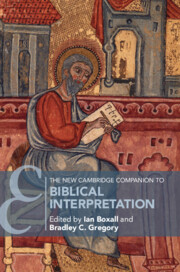Book contents
- The New Cambridge Companion to Biblical Interpretation
- Cambridge Companions to Religion
- The New Cambridge Companion to Biblical Interpretation
- Copyright page
- Contents
- Figures
- Contributors
- Acknowledgments
- Abbreviations
- Introduction
- Part I Methods
- Part II Frameworks/Stances
- Part III Reception
- Scripture Index
- General Index
- Cambridge Companions to Religion
Introduction
Published online by Cambridge University Press: 15 October 2022
- The New Cambridge Companion to Biblical Interpretation
- Cambridge Companions to Religion
- The New Cambridge Companion to Biblical Interpretation
- Copyright page
- Contents
- Figures
- Contributors
- Acknowledgments
- Abbreviations
- Introduction
- Part I Methods
- Part II Frameworks/Stances
- Part III Reception
- Scripture Index
- General Index
- Cambridge Companions to Religion
Summary
In the predecessor to this volume, John Barton observed that the interpretation of the Bible is never finished because new readers in a new time will inevitably ask new questions. Now almost a quarter century later, this is as true today as it was in 1998. Yet, it is not only that the results of the interpretive task change but that the concept and nature of interpretation itself undergoes transformation. Barton’s volume already noted the significant paradigm shifts in the field that were unfolding in the 1990s, in which the dominance of historical-critical methods as nearly synonymous with the idea of “biblical scholarship” was giving way to a range of competing approaches, several of which claimed affinity with older, pre-Enlightenment approaches. However, in his own essay in that volume, he also cautioned against a tendency to dismiss historical criticism (or, as he prefers, biblical criticism) too readily, making a strong case for the ongoing importance of the specific kinds of questions it poses to the text.
- Type
- Chapter
- Information
- Publisher: Cambridge University PressPrint publication year: 2022

